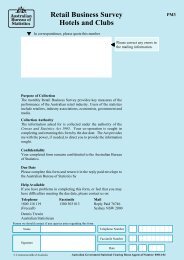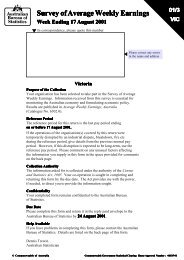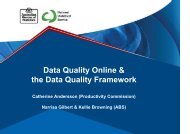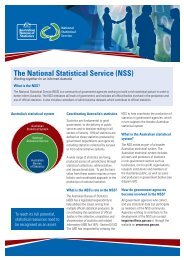SAE Manual Sections 1 to 4_1 (May 06).pdf - National Statistical ...
SAE Manual Sections 1 to 4_1 (May 06).pdf - National Statistical ...
SAE Manual Sections 1 to 4_1 (May 06).pdf - National Statistical ...
You also want an ePaper? Increase the reach of your titles
YUMPU automatically turns print PDFs into web optimized ePapers that Google loves.
A Guide <strong>to</strong> Small Area Estimation - Version 1.1 05/05/20<strong>06</strong><br />
4.2 The Modelling Framework<br />
Figure 4.1 presents a schematic representation of the small area modeling framework<br />
followed in this manual. Figure 4.2 complements Figure 4.1 by providing a list of key<br />
questions the purpose of which is <strong>to</strong> aid the decision making process of small area<br />
modeling in a reasonably systematic approach. The objective of these questions is <strong>to</strong><br />
help the modeller/analyst better understand the modeling framework (Figure 4.1) and<br />
hence be able <strong>to</strong> choose the most appropriate technique for a given set of data. This,<br />
however, does not mean these are the only questions that need <strong>to</strong> be raised in this kind<br />
of exercise.<br />
The left-hand-side of Figure 4.1 shows the simplest small area methods, these being the<br />
Direct and Broad Area Ratio estima<strong>to</strong>rs, which are frequently used in the absence of<br />
good quality auxiliary data. The answer <strong>to</strong> question 1 of Figure 4.2 is important as good<br />
quality auxiliary data is a key requisite in order <strong>to</strong> proceed <strong>to</strong> the regression-based small<br />
area estima<strong>to</strong>rs. We take good auxiliary data <strong>to</strong> mean area-level and/or unit-level data<br />
that are potentially correlated (both theoretically and empirically) with the variable of<br />
interest. Section 3.5 discusses some of the ways the quality of auxiliary data can be<br />
determined. The quality of the auxiliary data, therefore, has a large bearing on the<br />
reliability of model predictions for the variable of interest. In other words, when good<br />
quality auxiliary data is available one can choose among a number of regression-based<br />
estima<strong>to</strong>rs that “borrow strength” from the relationship between the variable of interest<br />
and the auxiliary data; thereby improving the quality of small area estimates/predictions.<br />
Australian Bureau of Statistics 28








